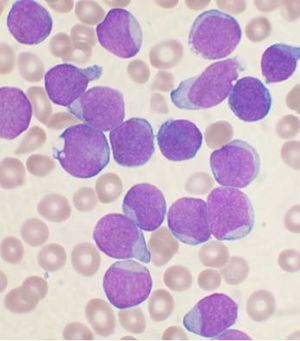Leukemia facts for kids
Leukemia is a type of cancer. It affects your white blood cells and bone marrow. When someone has leukemia, their body makes too many white blood cells. These are also called leukocytes.
There are different kinds of leukemia. It's part of a larger group of diseases called blood cancers. Without treatment, leukemia can be very serious. How a person is affected depends on the type of leukemia they have.
In 2000, about 256,000 people worldwide got leukemia. Most cases (about 90%) happen in adults.
Contents
What Are the Main Types of Leukemia?
Leukemia can be either acute or chronic. Acute leukemia usually grows quickly. Chronic leukemia grows slowly.
Leukemia can also affect two different types of white blood cells. These are lymphoid cells and young granulocyte cells. These young cells are called myelocytes.
Because of this, all the different forms of leukemia are put into four main types:
- Acute lymphocytic leukemia (ALL) is the most common type. It is often found in young children. Older people can also get it.
- Chronic lymphocytic leukemia (CLL) is usually seen in people over 55. Children almost never get this type.
- Acute myelogenous leukemia (AML) is more common in adults than in children.
- Chronic myelogenous leukemia (CML) happens mostly in adults.
What Causes Leukemia?
We do not know the exact causes of most types of leukemia. All cancers happen when cell division goes wrong. It is likely that different kinds of leukemia have different causes. Most known causes are things we cannot control.
Scientists believe some things might increase the chance of getting leukemia:
- Being around Ionizing radiation.
- Being around certain chemicals, like benzene.
- Certain viruses.
- Treatment with some medicines. For example, Chemotherapy for a tumor.
- Certain genetic factors.
Viruses that are thought to cause leukemia include:
Fanconi anemia is also a risk factor for getting acute myelogenous leukemia.
How Is Leukemia Treated?
Most cases of leukemia are treated with many medicines. These are usually given together in a chemotherapy program. Sometimes, radiation therapies or bone marrow transplants are done.
Images for kids
-
The increase in white blood cells in leukemia.
See also
 In Spanish: Leucemia para niños
In Spanish: Leucemia para niños





